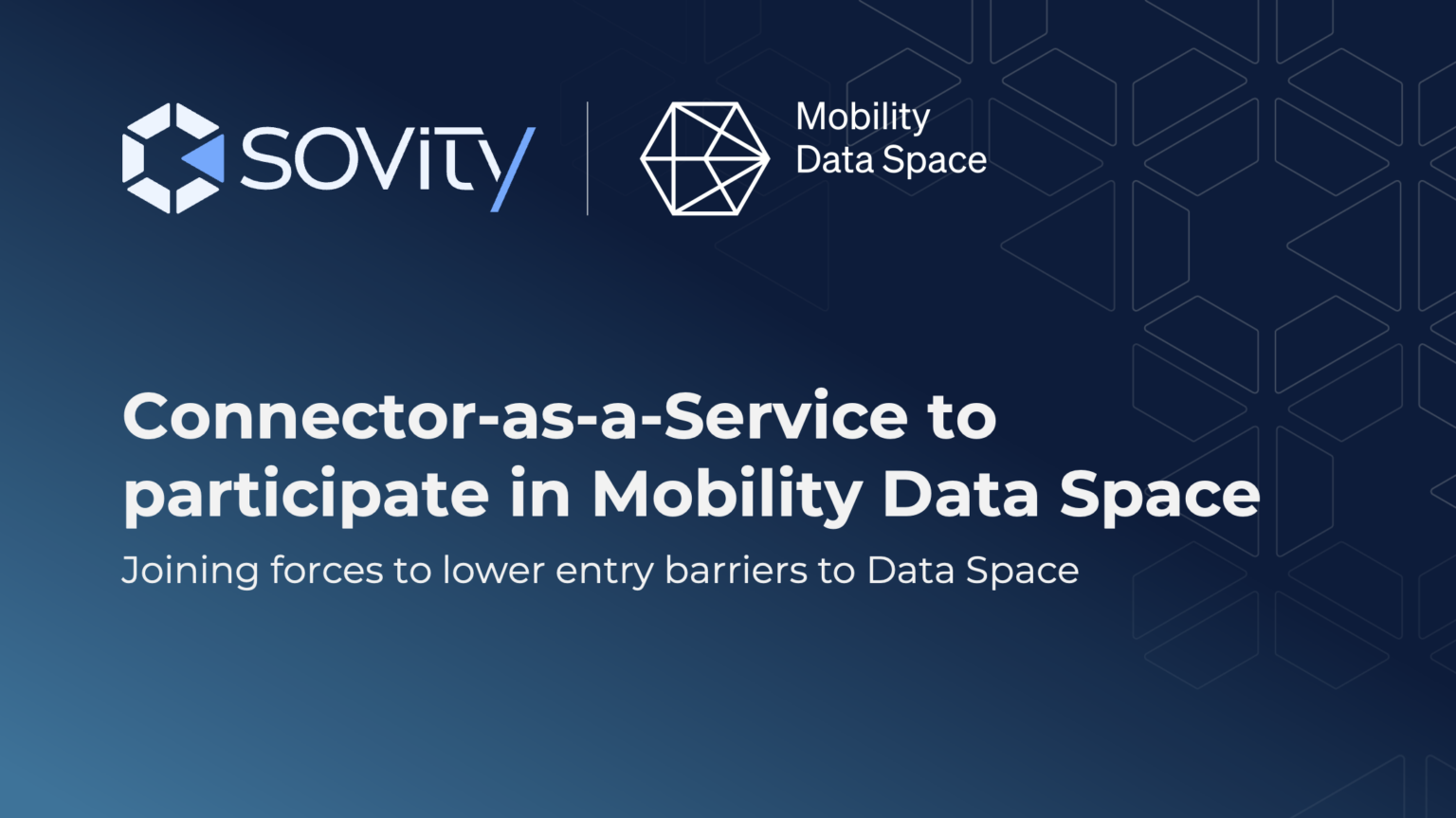The Mobility Data Space (MDS) was one of the first practical applications of the IDSA framework for Data Spaces and provides a marketplace for partners in the mobility sector to exchange data. Michael Schäfer is the Managing Director of the MDS and gives insights into the current developments of the Data Space and their cooperation with sovity.
The collaboration between sovity and Mobility Data Space started in 2021, when the MDS was shortly in front of the first releases of its operational live Data Space. sovity and MDS have been in close collaboration and cooperating on different topics ever since. Those topics started with the MDS Connector – sovity develops the MDS open-source Connector based on EDC. Furthermore, sovity provides further key Data Space software components to the MDS (e.g., the user portal or broker/marketplace).
Recently, MDS and sovity made a special announcement for MDS participants:

The Mobility Data Space and sovity will provide the Connector-as-a-Service to MDS participants to accelerate and facilitate utilisation of sovereign data exchange.
sovity interviewed Michael Schäfer (Managing Director of MDS) and Sebastian Kleff (CEO of sovity) on this special announcement. Enjoy the Interview with Michael and Sebastian.
sovity: Hello Michael, MDS is on a great trajectory. What are the goals/focuses of MDS for scaling its community and use cases over the next year?
Michael Schäfer: We will continue to make the technical operating environment more robust and more scalable. Step by step, the components that have been existing so far will be further improved and, in some cases, even replaced. We are currently working intensively on driving standardization forward. An important aspect are the GAIA-X Federated Services (GXFS). We are investigating which of these can help the MDS and its participants to make the adoption easier to use and to scale. All of that striving to provide an even more secure and robust operating environment and making onboarding and use easier: making it easier to connect to the MDS. Data offers can be added to the catalog quickly and easily. And consuming of data becomes more smart and smooth.
sovity: Hi Sebastian, MDS and sovity have collaborated for some time now. Could you please describe the collaboration between sovity and MDS.
Sebastian Kleff: The collaboration between sovity and Mobility Data Space started in 2021, when the MDS was shortly in front of the first releases of its operational live Data Space. Since that time, we have been in close collaboration and cooperating on different topics. Those topics started with the MDS Connector – sovity develops the MDS open-source Connector based on EDC. Furthermore, we provide further key Data Space software components to the MDS (e.g., the user portal or broker/marketplace).
One new way of collaboration started just recently: We are providing the Connector-as-a-Service to all users and participants of the MDS.
sovity: Michael, what challenges has MDS identified among its members that will now be addressed with CaaS?
Michael Schäfer: Overall, we still find that the topic of Data Spaces and their use requires a lot of awareness. In a federated horizontal ecosystem, the software component used by companies in order to participate in the community plays the central role: the Connector. It has become apparent that installation and operation of the open-source Connector that has been existing in the past overwhelmed many. Thus, this was a major hurdle for potential market participants. Therefore, the Connector-as-a-Service (CaaS) plays a crucial role: the technical onboarding effort is completely eliminated and participants can start using it right away. MDS customers also do not have to worry about operations and maintenance: everything happens invisibly and silently in the background. This means that Data Space participants can focus on their applications and business.
sovity: What is the Connector-as-a-Service and what are its benefits? Can you describe this with an example use case?
Michael Schäfer: The key benefits are seamless onboarding and zero administration operations. Data Space participants can entirely focus on their applications and business. This can be illustrated with the application of improving the charging station infrastructure: this is a complex issue in which many players have to work together. We are talking about large and small companies, public institutions, and players from the private sector. All of them start with very different prerequisites and knowledge. The CaaS makes it possible for everyone to come together quickly and exchange data. If additional data is needed from new participants, the CaaS helps to bootstrap them very quickly and make them another part of the data ecosystem.
sovity: How can MDS participants receive the CaaS?
Michael Schäfer: It’s so simple you won’t believe it. Register for Mobility Data Space by simply signing the partcipants agreement and the CaaS will automatically be made available to you. Since it is a cloud service, you can easily access it using a browser and your login credentials. Without code, you can then connect your backend systems as a source if you want to provide data, or as a sink if you want to consume data respectively.
sovity: Sebastian, how exactly does the Connector-as-a-Service (CaaS) enable users in MDS?
Sebastian Kleff: The Connector allows the data exchange between participants in the MDS based on open standards such as IDS and Gaia-X. The Connector technology is complex, and its configuration and setup require deep technical skills.
The users of MDS are companies within the mobility domain – from large mobility providers such as Deutsche Bahn or ADAC to small local utility companies for public transportation. Yes, those parties aim to share and use data, however they are mostly not interested in taking care of the foundational technology.
With the sovity Connector-as-a-Service the users receive access to the relevant data sharing technology of MDS within minutes and without the need of technical expertise. We take care of underlying infrastructure and the users just need to login to a web application to grant access to MDS. The companies can share and consume data immediately to create new mobility services or create data-driven business models.
sovity: Michael, in which areas does the MDS cooperate with sovity? What are the advantages of this cooperation?
Michael Schäfer: First of all, sovity are an important member of our „vendor zoo“ and a loyal partner. sovity have supported us from the beginning and are responsible for part of the software components that keep the MDS running. In addition, they help us with their wealth of knowledge and network not to miss new trends and developments in the Data Spaces area. By supporting the participants of the Data Space community, they help to grow and scale the entire Data Ecosystem. We are very happy and proud to have sovity with us and are very much looking forward to making the Mobility Data Space even more successful together with them.
sovity: Sebastian, what are the next steps between MDS, sovity and MDS participants?
Sebastian Kleff: Jointly, we will provide the CaaS to all participants of MDS – free of charge! Companies can start building their proof-of-concepts and realize their use cases. We are happy to support this process by tailoring the CaaS functionality according to the user needs. We would like to accelerate the usage of Mobility Data Space and taking efforts to make the user experience as good as possible.
sovity: Thank you for this Interview!

Michael Schäfer – Managing Director of Mobility Data Space

Sebastian Kleff – CEO and Co-founder of sovity
Are you currently preparing yourself for Mobility Data Space, Catena-X or other Data Spaces based on Gaia-X and International Data Spaces technologies? Are you interested in a trial of sovity’s newest CaaS?
Presscontact sovity: Sebastian Kleff, contact@sovity.de
